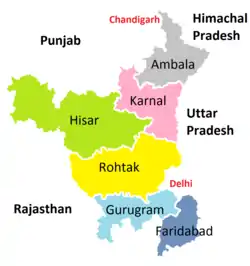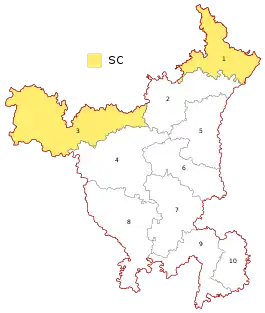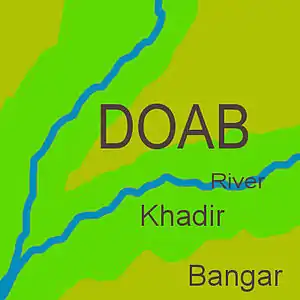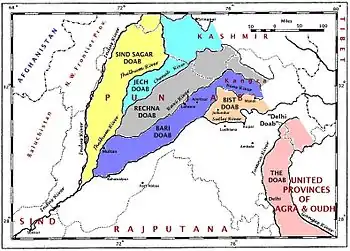Administrative divisions of Haryana
Haryana, formed on 1 November 1966, is a state in North India. It is divided into 6 revenue divisions, 5 Police Ranges and 3 Police Commissionerates (c. January 2017).[1][2][3][4]

Administrative divisions
Civil administration and revenue divisions
Administration of Haryana is divided into Revenue divisions composed of districts. Districts are further subdivided in to tehsils of the revenue administration and the Community development blocks for the development work.
Haryana has 6 administrative divisions, 22 districts, 73 sub-divisions, 93 revenue tehsils, 50 sub-tehsils, 140 community development blocks, 154 cities and towns, 6,841 villages and 6212 villages panchayats.[5][6]
| Divisions | Districts |
|---|---|
| Ambala | Ambala, Kurukshetra, Panchkula, Yamuna Nagar |
| Faridabad | Faridabad, Palwal, Nuh |
| Gurugram | Gurugram, Mahendragarh, Rewari |
| Hisar | Fatehabad, Jind, Hisar, Sirsa |
| Rohtak | Jhajjar, Charkhi Dadri, Rohtak, Sonipat, Bhiwani[6] |
| Karnal | Karnal, Panipat, Kaithal |
Electricity distribution zones
Haryana Power Generation Corporation is responsible for producing and procuring power,[7][8] and following two Government of Haryana PSUs are responsible for the distribution of electricity to the consumers and industries in the south and north zone respectively:
- Dakshin Haryana Bijli Vitran Nigam, south zone distributor.[9][10]
- Uttar Haryana Bijli Vitran Nigam, north zone distributor.
Irrigation commands
There are 6 command areas based on the systems of arterial supply canal and its enduser branches and feeders.
- Bhakra Canal Command: Fed by Sutlej river, controls Bhakra Canal network within northern Haryana along Punjab border in the districts of Kaithal, northern Jind (Narwana), Sirsa, fatehabad, parts of Hisar (down to Hisar city).
- Yamuna Canal Command: Fed by Western Yamuna Canal, controls this network within northeastern, east and central Haryana in the districts of Karnal, Jind, Rohtak, Hansi-I area of Hisar, Tosham. Bhiwani, Jhajjar, Rohtak, Sonepat, Panipat, and Karnal.
- Siwani Canal Command: Fed by Western Yamuna Canal command, covers Siwani, Isharwal, Jhumpa areas of Bhiwani district.
- Jui Canal Command: Fed by Western Yamuna Canal command, covers narrow tract of Kairu and Jui in Bhiwani district.
- Loharu Canal Command: Fed by Western Yamuna Canal command, covers districts of Charkhi Dadri and Loharu and Bahal areas of Bhiwani.
- JNL Canal Command: Fed by Western Yamuna Canal command, covers districts of Rewari and Mahendragarh.
- Gurugaon Canal Command: Fed by Western Yamuna Canal command, covers tract of Gurugaon, Nuh, Ferozepur Jhirka, Faridabad city, etc.
- Agra Canal Command: Directly fed by Yamuna river, covers narrow tract of Ballabhgarh and Palwal district.
Civil defence and police divisions
Police commissionerates
Police commissionerates of Haryana, total 3 in number, are as follows (c. January 2019):[1]
| Commissionerate | Urban area |
|---|---|
| Faridabad Commissionerate | Faridabad |
| Gurugram Commissionerate | Gurugram |
| Panchkula Commissionerate | Panchkula |
Police ranges
Police ranges of Haryana, total 5 in number, each headed by an officer not below the rank of ADG of Police reporting to the Director General of Police, are as follows (c. September 2018):[11]
| # | Police range | Districts |
|---|---|---|
| 1 | Ambala | Ambala |
| Yamunanagar | ||
| Kurukshetra | ||
| 2 | Hisar | Hisar |
| Hansi (Police District) | ||
| Fatehabad | ||
| Sirsa | ||
| Jind | ||
| 3 | Karnal | Karnal |
| Panipat | ||
| Kaithal | ||
| 4 | Rewari | Mahendragarh |
| Rewari | ||
| Palwal | ||
| Nuh | ||
| 5 | Rohtak | Rohtak |
| Jhajjar | ||
| Sonipat | ||
| Bhiwani | ||
| Charkhi Dadri |
Electoral divisions
Lok Sabha

For electing the national-level Government of India, there are 10 Lok Sabha constituencies in Haryana. Current Lok Sabha constituencies in Haryana are: Ambala, Bhiwani–Mahendragarh, Faridabad, Gurgaon, Hisar, Karnal, Kurukshetra, Rohtak, Sirsa, and Sonipat.
Vidhan sabha

For electing the state-level Government of Haryana, there are 90 vidhan sabha constituencies of Haryana Legislative Assembly, of which 17 are reserved constituencies for the scheduled castes.
Forests and wildlife divisions
Principal Chief Conservator of Forests head the Forests Department, Haryana, there are separate two divisions each for wildlife and forests:
Forests zones
There are 2 Forests Protections zone and 4 Forests circles/divisions, i.e. 2 circles per zone.[12]
- Forests Protection zone-1: Panchkula, covers geographical northern half of Haryana.[12] It consists of North Forests Circle/Division which covers northeast geographical quadrant of Haryana including Shivalik Hills and down to Sonipat.[12] and West Forests Circle/Division which Covers northwest geographical quadrant of Haryana including Sirsa, Hisar, Jind.[12]
- Forests Protection zone-2: Based at Gurugram, covers geographical southern half of Haryana.[12] It consists of Central Forests Circle/Division which covers central geographical quadrant of Haryana including Rohtak, Jhajjar, Charkhi Dadri, Bhiwani, Mahendragarh etc.[12] and South Forests Circle/Division which covers geographical South Haryana including Faridabad, Nuh, Palwal, etc.[12]
Wildlife areas
- Wildlife zones
There are two Wildlife zones, each headed by the Chief Conservator of Wildlife.[12]
- Wildlife North zone: Based at Panchkula, covers geographical northern half of Haryana including Shivalik Hills to Sirsa, to Hisar to Rohtak.[12]
- Wildlife South zone: Based at Gurugram, covers geographical southern half of Haryana including Charkhi Dadri, Bhiwani, Mahendragarh, Nuh, palwal, Gurugram, Faridabad, etc.[12]
- Wildlife corridors
- Sariska-Delhi leopard corridor
- Sahibi wildlife corridor (planned)
- Shivalik wildlife corridor
- Yamuna wildlife corridor
- National parks and protected areas
See List of national parks and wildlife sanctuaries of Haryana.
Geographical regions
Aravalli
Areas of Haryana lying in Aravalli hills range mostly fall within Ahirwal and Mewat regions.
- Dhundhoti: Historic region which covered present day districts of Gurugram has its seat of power at Garhi Harsaru.
- Bighoto: Historic region which covered present day districts of Rewari and Mahendragarh.
- Chandain: Historic region, which covered which covered 12 villages of Taoru, was a subdivision of the bigger Bighoto region, which in turn was part of Alwar State.
Bagar
Bagar tract or Bagad (बागड़), from "Bar" meaning the dry country,[13] refers to the sandy tract of north-western India and eastern parts of current Pakistan bordering India.[14] In Haryana, it covers southern parts of Sirsa district (earlier known as Bhattiana), and western villages of Fatehabad, Hisar, Bhiwani and Charkhi Dadri districts.[15][16] in Rajasthan on the west of border of Haryana, it covers parts of tehsils of Ganganagar; Bhadra, Nohar in Hanumangarh district; Taranagar tehsil in Churu district.[15][17] Bhattiana, a historical region ruled by the Bhati Rajputs in the past, is a part of bagar tract covering Sirsa and Fatehabad district. Chak, type of villages, were established in the northern part of this tract along the canal network during British raj. Smaller settlements in the farms are called dhani.
Bangar

.
Rest of upland Haryana, which does not get flooded, except other regions mentioned in this section. This covers the districts of Rohtak, southern part of Jind, non-bagar tracts of Hisar and Bhiwani, Charkhi Dadri and Jhajjar, non-Khadir areas (east of Grant Trunk Road) of Sonepat, Panipat and Karna, southwest Kurukshetra and southern Kaithal. This area is also called Deshwal.
GT Road belt
GT Road belt is the geographical area on either side of the Grand Trunk Road from Delhi to Ambala. Upland areas around Indri north of Karnal is called Nardak.
Khadir
Khadir (खादर) is any low-lying floodplains of a river usually relatively narrower compared to unflooded bangar area. Khadar areas are prone to flooding and sometimes include portions of former river-beds that became available for agriculture when a river changes course. It is moisture retentive and sticky when wet.[18][19] Khadir soil consists of new alluvial soil relatively higher in new silt content from the river, gets replenished with each flooding cycle,and is often very fertile.[19] Haryana has two such floodplains, Yamuna Khadir and Nali.
Yamuna khadir
Yamuna Khadir, or simply Khadir, is a fertile floodland area lying between the Yamuna river and the Grand Trunk Road, i.e. eastern parts of Sonepat, Panipat, Karnal and Kurukshetra as well as southeastern Yamunanagr district.
Nali khadir
Nali area, or simply Nali (नाळी), is the fertile floodland Khadir area in Fatehabad and Sirsa districts between the Ghaggar river and the southern limits of the Saraswati palaeochannel depression that gets flooded during the rains.[20]
Shivalik
Areas of Haryana lying in Siwalik Hills range, i.e. northern parts of Panchkula and Yamunanagar district as well as Naraingarh tehsil of Ambala.
Industrial zones and corridors
HSIIDC has developed at least 11 specialised "Industrial Clusters and Theme Parks", 24 "Industrial Estate (IE)" (each wit an area larger than at least 1500 acres), "Industrial Model Township (IMT)" (smaller than 1500 acres), and an IT Park (denoted by double asterisk or star symbol). Haryana has at least 24 IEs, 7 IMT, an IT Park, and several Integrated Multimodel Logistics Hubs (IMLH) in the state of Haryana.[21][22]
- Textile Hub, Panipat
- IIDC Narwana in Jind
- Food Park, Saha
- Growth Centre, Saha
- Footwear Park, Bahadurgarh
- Apparel Park, Barhi
- Theme Park, Kundli
- Electronic Hardware Technology Park, Kundli
- EPIP, Kundli
- Food Park, Rai
- Mega Food Park, Rai
- Industrial estates and townships
See the list of 30+ industrial estates and townships spread across Haryana.
Interfluve

Doab (interfluve) is land lying between two confluent rivers[23][24][25]
Extant doab
- Sarsuti-Ghaggar doab: It is the only extant doab which covers the entire length of northern border of Haryana with Punjab, i.e. districts of Panchkula, eastern Yamunanagar, Ambala, northern Kurukshetra, Kaithal, northern Jind, northern Fatehabad and northern Sirsa.
Palaeo doab
- Sarasvati-Yamuna doab / Ghaggar-Yamuna doab: Almost all of the northern border of Haryana is roughly defined by the course of present-day seasonal Sarsuti river, which is one of many Palaeochannel of Sarasvati river. It is now the tributary of present-day Ghaggar river, which is currently the most volumnous or main ramnant channel of Sarasvati river. Almost all of the eastern border of Haryana is roughly defined by the course of Yamuna river. Area between the ancient Sarasvati (with its several palaeochannelin Haryana, including Sarsuti and Ghaggar, and the largest paleo tributary Dhrisdhavati) and Yamuna is called the Sarasvati-Yamuna doab. According to the paleo studies, the earliest paleo channel of Sarasvati flowed southeast collecting Sahibi river and confluencing with Yamuna. This Sarasvati-Yamuna doab covered the area of districts of Panchkula, Ambala, Yamunanagr, Kurukshetra, Kaithal, parts of Jind, Karnal, Panipat, Sonepat, Rohtak, Jhajjar and Gurugram. It remains a matter of further study if Sarasvati ever confluenced with Ganges-Yamuna at Prayagraj as elluded to in the Hindu texts, if this hypothesis if found to be true, Sarasvati would have also flowed through Rwari, Fridabad and Nuh districts of Haryana and would have collected Chambal and Betwa rivers as its tributories. Since Sarasvati and Yamuna no longer confluence, this palaeo Sarasvati-Yamuna doab no longer exists. Only extant doab in Haryana is Sarsuti-Ghaggar doab. Palaeo Sarasvati-Yamuna doab could be subdivided into the following doabs of Drishadvati-Sahibi doab, Drishadvati-Sahibi doab and Sahibi-Yamuna doab.
- Sarasvati-Drishadvati doab / Ghaggar-Drishadvati doab: This palaeo doab covered the area lying between Ghaggar river (palaeochannel of Sarasvati) and the palaeochannel Drishadvati river which confluenced in Hanumangarh district immediately northwest of Haryana. This doab area included entire Northern Haryana on Haryana-Punjab, i.e. districts of Panchkula, Ambala, Yamunanagar, Kurukshetra, Kaithal, Jind, northern part of Hisar, Fatehabad and Sisra.
- Drishadvati-Sahibi doab / Ghaggar-Sahibi doab: This palaeo doab covered the area of northwestern Haryana, i.e. districts of Sirsa, Fatehabad, Hisar, Bhiwani, Charkhi Dadri and Mahendragarh.
- Sahibi-Yamuna doab: This palaeo doab covered the area lying between Sahibi river and Yamuna. This doab area included South Haryanam i.e. districts of Rewari, southern Gurugam, Southern Faridabad, Nuh and Palwal.
Martial zones
The modern military history commenced with British colonial rule when George Thomas established modern European style army in 1798 to 1801,[26][27] and later Colonel James Skinner (1778 – 4 December 1841) the Anglo-Indian military adventurer in India founded 1st Skinner's Horse and 3rd Skinner's Horse at Asigarh Fort at Hansi in 1803 which is now part of the Indian Army.[28][29]
Military zones
- Current military stations
- Defunct British Raj cantonments
- Asigarh Fort (Prithviraj Chauhan, George Thomas, Skinner)
- Karnal Cantonment (British raj)
- Bharawas (Company rule)
- Jharsa (Begum Samru)
- Defunct princely state garrisons (^ denotes abolished in 1858)
- Jat Raja (Hindu-Sikh)
- Buria of Jat Sikh
- Balramgarh^ of Hindu Raja Nahar Singh
- Jind State of Phulkian Jat Sikh
- Kaithal State of Phulkian Jat Sikh
- Kalsia of Jat Sikh
- Kapurthala State (Narwana) of Phulkian Jat Sikh
- Pathan Nawab (Muslim)
- Bahadurgarh^ of Muslim Pathan
- Dujana^ of Yusufzai Pathan Muslim
- Jhajjar^ of Pathan Muslim[30]
- Loharu State of Pathan Muslim
Para-military zones
This is a partial list, please help expand.
- Border Security Force
- Hisar BSF Camp
- Central Industrial Security Force (CISF)
- Mandawar CISF, Sohna[31]
- Central Reserve Police Force (CRPF)
- Hisar CRPF Camp
- National Security Guard (NSG) at Manesar
Tourist and archaeological zones
Haryana State Directorate of Archaeology & Museums and Haryana Tourism are responsible for archaeology and tourism in Haryana respectively.
- Highest point
- National monuments
- State monuments
- Indus-Sarasvati civilisation sites
- Monuments and memorials
- Culture
- Dams
- Forts
- Lakes
- Mountains
- Museums
- Music
- Temples
- Tourist attractions
- Other
Transport
Aviation zones
Haryana has 6 civil and 2 military aviation zones / airports. See airports in Haryana.
- Civil
- Military
- National and state capitals
Integrated multimodel logistics hubs
There are many existing and proposed Integrated Multimodel Logistics Hubs (IMLH) in the state of Haryana including the following existing IMLH with containerised road and rail facilities and/or air facilities (denoted by asterisk):[21]
- Manesar road cargo and railway sliding for Maruti Suzuki on Western Peripheral Expressway.
- Nangal Choudhary IMLH on Delhi–Mumbai Industrial Corridor.
- Pinjore IMLH* for the fruits on Ambala Chandigarh Expressway. Bilaspur to be developed as spoke with railway sliding on the proposed Chandigarh-Yamunanagar rail line.
- Sonipat inland container depot and logistics park on Delhi-Chandigarh NH1.[32] Kharkhoda Footwear IMLH in Sonipat under implementation with containerised road and rail cargo.
Roard corridors
Railway zones and dedicated corridors
Parts of the following 3 zones and their 5 subordinate divisions of Indian Railway fall within Haryana:
- Dedicated Freight Corridors
- Railway zones
- North Western Railway zone
- Bikaner railway division covers western and southern Haryana including Bhatinda-Dabwali-Hanumangarh line, Rewari-Bhiwani-Hisar-Bathinda line, Hisar-Sadulpur line and Rewari-Loharu-Sadulpur line.[33][34]
- Jaipur railway division covers south-west Haryana including Rewari-Reengas-Jaipur line, Delhi-Alwar-Jaipur line and Loharu-Sikar line.[35]
- Northern Railway zone
- Delhi railway division covers north and east and central Haryana including Delhi-Panipat-Ambala line, Delhi-Rohtak-Tohana line, Rewari–Rohtak line, Jind-Sonepat line and Delhi-Rewari line.[36][37][38][39][40]
- Ambala railway division covers north-east Haryana including Ambala-Yamunanagar line, Ambala-Kurukshetra line and UNESCO World Heritage Kalka–Shimla Railway.[41] There are 2 Workshops in this division which falls within Haryana: Carriage & Wagon Workshop, Jagadhari and Carriage & Wagon Workshop, Kalka for narrow gauge.[42]
- North Central Railway zone
- Agra railway division covers very small part of network in south-east Haryana which includes Palwal-Mathura line only.[43][44]
See also
- History of Haryana
- List of districts of Haryana
- List of tehsils of Haryana
- List of Haryana-related lists
- Outline of Haryana
References
- Reorganisation of Haryana divisions, Daily Pioneer, 3 January 2017.
- Haryana approves to create two new revenue divisions, 2 February 2017.
- Authority set up to rejig administrative units across Haryana, Times of India, 3 January 2017.
- Haryana approves to create two new revenue divisions, Web India, 2 February 2017.
- "Haryana State Budget 2017–18" (PDF). Haryana Finance Dept. Retrieved 7 October 2017.
- NIDM, p. 3.
- HPGCL
- HPGCL power plant capacity
- "Address of various offices under DHBVN". DHBVN. Archived from the original on 19 January 2012. Retrieved 10 July 2012.
- "Dakshin Haryana Bijli Vitran Nigam(DHBVN) – Department of Power". dhbvn.org.in. Retrieved 14 December 2017.
- Haryana establishes five police ranges, business Standard, 16 January 2017.
- Haryana Forests Manual
- Nonica Datta, "Forming an identity", The Tribune, 3 July 1999.
- "Revised Land and Revenue Settlement of Hisar District 9006–9011" (PDF). Archived from the original (PDF) on 17 May 2017. Retrieved 26 March 2016.
- Gusain, Lakhan: Reflexives in Bagri. Jawaharlal Nehru University, New Delhi, 1994
- Gusain, Lakhan: Limitations of Literacy in Bagri. Nicholas Ostler & Blair Rudes (eds.). Endangered Languages and Literacy. Proceedings of the Fourth FEL Conference. University of North Carolina, Charlotte, 21–24 September 2000
- India District Census Handboook, 1961
- Yash Pal Singh (1920), भूगोल (Geography), VK Publications, ISBN 978-81-89611-21-7,
... मैदान के उस भाग को बांगर कहते हैं जहाँ नदियों की बाढ़ का पानी नहीं पहुंच पाता ... पुरानी जलोढ़ मिट्टी ... खादर: यह वह क्षेत्र है जहाँ नदियों की बाढ़ का जल प्रतिवर्ष आ जाता है ...
- Kiran Prem,1994, Haryana District Gazetteers: Faridabad, Haryana, Page 16.
- "The imperial gazetteers of India, 1908", British Raj, page 288.
- HSIIDC Industrial Clusters and Theme Parks.
- HSIIDC branches and estates.
- doab or duab, n., OED Online, Oxford University Press, March 2014, retrieved 24 April 2019 Quote: "Originally and chiefly in South Asia: (the name of) a strip or narrow tract of land between two rivers; spec. (with) the area between the rivers Ganges and Jumna in northern India."
- doab or duab, n., OED Online, Oxford University Press, March 2014, retrieved 24 April 2019 Quote: "confluence, land between two rivers, used in India of the tongue of land between the Ganges and Jumna, and of similar tracts in the Punjab, etc., lit. 'two waters' "
- Doab., Webster's Third New International Dictionary, Unabridged., 2013, retrieved 24 April 2019 Quote: " a tract of land between two rivers : interfluve"
- Desi Irish Raja of Haryana, TIme of India newspaper, Jul-24-2016
- Military memoirs of George Thomas, William_Francklin, 1805
- Colonel James Skinner CB Archived 18 December 2010 at the Wayback Machine National Army Museum (British Army).
- Chisholm, Hugh, ed. (1911). . Encyclopædia Britannica. 25 (11th ed.). Cambridge University Press. p. 192.
- ‘He who rode a tiger’, The Tribune India, 16 February 2014.
- Ten big projects approved in Haryana, 29 January 2019.
- Sonepat Logistics Park.
- Bikaner Division map and history
- "Overview of Bikaner Division" (PDF). North Western Railway. Archived from the original (PDF) on 8 May 2014. Retrieved 7 May 2014.
- Jaipur division network map
- Delhi division map and history
- "Zones and their Divisions in Indian Railways" (PDF). Indian Railways. Archived from the original (PDF) on 19 March 2015. Retrieved 13 January 2016.
- "Ambala Railway Division". Railway Board. Northern Railway zone. Retrieved 13 January 2016.
- "Statement showing Category-wise No.of stations in IR based on Pass. earning of 2011" (PDF). Archived from the original (PDF) on 28 January 2016. Retrieved 15 January 2016.
- "PASSENGER AMENITIES – CRITERIA= For Categorisation of Stations" (PDF). Archived from the original (PDF) on 4 March 2016. Retrieved 15 January 2016.
- Ambala Division map and history.
- Kalka workshop
- NCR Zone map
- "North Central Railways / Indian Railways Portal". www.ncr.indianrailways.gov.in. Retrieved 4 December 2017.
| Wikimedia Commons has media related to Divisions of Haryana. |




